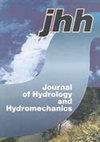Experimental investigation of hydrophobic bentonite effects on reducing evaporation from water surfaces
IF 2.4
4区 环境科学与生态学
Q3 WATER RESOURCES
引用次数: 0
Abstract
Abstract In recent years, due to the occurrence of water shortage and drought problems, particularly in arid and semi-arid regions of the world, new methods to reduce evaporation from the surface of dam reservoirs, lakes, and other water-free surfaces are investigated. This study aimed to use hydrophobic bentonite to reduce water evaporation from water surfaces, on a laboratory scale, and field conditions for the first time. Bentonite initially became hydrophobic by stearic acid (SA). Under such conditions, hydrophobic bentonite floats on the surface of water and forms a thin coating layer. The produced hydrophobic bentonite had a contact angle of 150°, indicating its superhydrophobicity. Evaporation reduction was measured under laboratory and field conditions and it was compared to hexadecanol as the reference material. The results demonstrated that the hydrophobic bentonite efficiency under laboratory conditions was similar to that of hexadecanol and prevented water evaporation by 36%. However, under field conditions, hydrophobic bentonite and hexadecanol efficiencies were 40% and 23% to reduce evaporation for 30 days, respectively. In terms of stability, hexadecanol needed to be re-injected after three days, while hydrophobic bentonite was stable and remained on the surface for more than 100 days under laboratory conditions and for more than 15 days under field conditions without needing re-injection. This coverage with method can be used to reduce evaporation from lakes, tanks, and reservoirs of small dams.疏水性膨润土降低水面蒸发的实验研究
摘要近年来,由于缺水和干旱问题的发生,特别是在世界干旱和半干旱地区,人们研究了减少大坝水库、湖泊和其他无水表面蒸发的新方法。本研究旨在首次在实验室规模和现场条件下使用疏水性膨润土来减少水面的水分蒸发。膨润土最初因硬脂酸(SA)而变得疏水。在这种条件下,疏水性膨润土漂浮在水面上,形成一层薄薄的涂层。所制备的疏水性膨润土的接触角为150°,表明其具有超疏水性。在实验室和现场条件下测量蒸发减少量,并将其与十六烷醇作为参考材料进行比较。结果表明,在实验室条件下,疏水膨润土的效率与十六烷醇相似,并可防止36%的水分蒸发。然而,在现场条件下,疏水性膨润土和十六烷醇的效率分别为40%和23%,以减少30天的蒸发。就稳定性而言,十六烷醇需要在三天后重新注入,而疏水性膨润土是稳定的,在实验室条件下在表面停留超过100天,在现场条件下在不需要重新注入的情况下停留超过15天。这种覆盖方法可用于减少小型水坝的湖泊、水箱和水库的蒸发。
本文章由计算机程序翻译,如有差异,请以英文原文为准。
求助全文
约1分钟内获得全文
求助全文
来源期刊
CiteScore
4.20
自引率
5.30%
发文量
30
审稿时长
>12 weeks
期刊介绍:
JOURNAL OF HYDROLOGY AND HYDROMECHANICS is an international open access journal for the basic disciplines of water sciences. The scope of hydrology is limited to biohydrology, catchment hydrology and vadose zone hydrology, primarily of temperate zone. The hydromechanics covers theoretical, experimental and computational hydraulics and fluid mechanics in various fields, two- and multiphase flows, including non-Newtonian flow, and new frontiers in hydraulics. The journal is published quarterly in English. The types of contribution include: research and review articles, short communications and technical notes. The articles have been thoroughly peer reviewed by international specialists and promoted to researchers working in the same field.

 求助内容:
求助内容: 应助结果提醒方式:
应助结果提醒方式:


